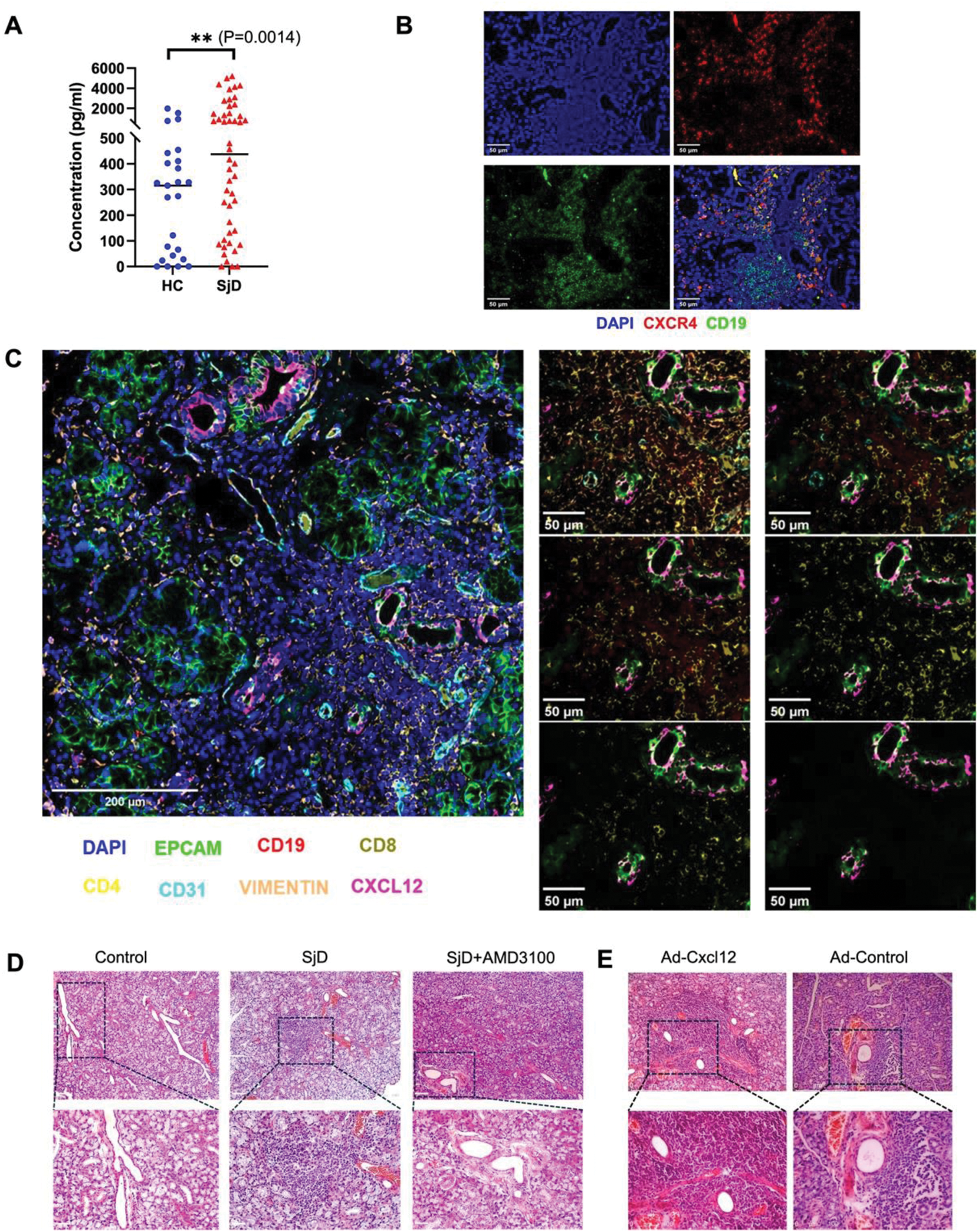

Background: Sjӧgren’s disease (SjD) is an autoimmune disease mainly involving exocrine glands. Lymphocyte infiltration is an important part of the damage to SjD glands, but the underlying mechanism is unclear.
Objectives: This study aimed to confirm the role of the chemokine CXCL12 and its receptor CXCR4 in SjD.
Methods: Bulk RNA-sequencing, single-cell RNA-sequencing, ELISA, qPCR, and multiplex immunofluorescence analysis were used in the study to examine CXCL12 and CXCR4 levels and their expression pattern. To confirm the role of CXCL12/CXCR4 in SjD, an experimental SjD animal model was conducted, and the mice were treated with the CXCL12/CXCR4 inhibitor AMD3100. To determine whether overexpression of Cxcl12 could exacerbate lymphocyte infiltration, Cxcl12-adeno-associated virus (Ad-Cxcl12) or vector control (Ad-Control) was delivered to the submandibular glands of SjD mice.
Results: Bulk RNA-seq data showed that the transcriptional levels of CXCL12 and its receptor CXCR4 in the labial gland biopsy of patients with SjD were significantly higher than those in the non-SjD group. Significantly elevated levels of CXCL12 in the serum of patients with SjD compared to healthy controls were also observed (Figure 1A). CXCR4 expression was significantly upregulated in the labial glands of SjD group, colocalizing with CD19 + B cells (Figure 1B). Multiplex immunofluorescence analysis showed high expression of CXCL12 in the epithelial cells of labial glands, consistent with Single-cell RNA-seq data (Figure 1C). In the SjD animal model, treatment with AMD3100 led to marked improvements in clinical symptoms, including reduced corneal damage, increased tear secretion and salivary flow rate. Histological analysis showed a significant reduction in lymphocytic infiltration in the lacrimal and salivary glands after AMD3100 treatment (Figure 1D). A decreased proportion of germinal center (GC) B cells in draining lymph nodes was also observed, suggesting that CXCL12/CXCR4 was involved in the pathogenesis of SjD by regulating GC B cells. Overexpression of CXCL12 in the submandibular glands of SjD mice exacerbated the functional impairment and lymphocyte infiltration in salivary glands (Figure 1E).
Conclusion: This study suggested that the CXCL12/CXCR4 axis was upregulated and contributed to the pathogenesis of SjD. The therapeutic application of the CXCL12/CXCR4 inhibitor AMD3100 demonstrated considerable potential in alleviating clinical symptoms and reducing glandular inflammation in SjD animal model. These results highlight the CXCL12/CXCR4 axis as a promising target for the development of new therapeutic strategies for SjD.
REFERENCES: NIL.
(A) CXCL12 levels in the sera of patients with Sjögren’s disease (SjD) compared to healthy controls (HC) were measured by ELISA. (B) Representative immunofluorescence images illustrating the colocalization of CXCR4 with CD19 in salivary glands. Scale bars, 50 µm. (C) Immunofluorescence staining shows colocalization of CXCL12 with immune cells and structural markers in the salivary glands of SjD patients. Scale bars, 200µm (left panel) and 50 µm (right panels). (D) Histological analysis of the salivary glands with H&E staining in Control, SjD, and SjD+AMD3100 groups. Enlarged images of selected areas are shown. Scale bars, 200 µm (top panels) and 100 µm (bottom panels). (E) H&E staining images of the salivary glands are shown for Ad-Cxcl12 and Ad-Control groups. Enlarged images of selected areas are shown below. Scale bars, 200 µm (top panels) and 100 µm (bottom panels).

Acknowledgements: NIL.
Disclosure of Interests: None declared.
© The Authors 2025. This abstract is an open access article published in Annals of Rheumatic Diseases under the CC BY-NC-ND license (